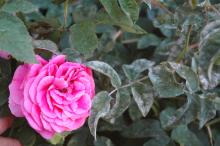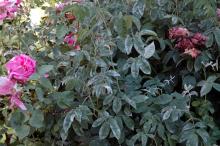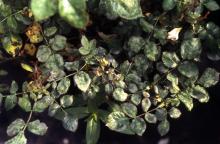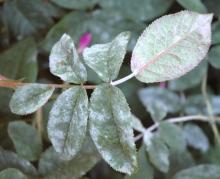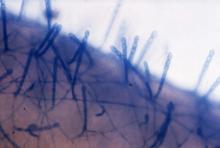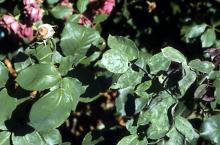See:
Cause Podosphaera pannosa (formerly Sphaerotheca pannosa), a fungus that overwinters in infected buds, rose leaves, twigs and branches. Infected buds grow in spring but are stunted and white with fungal conidia. Conidia are released in response to abrupt decreases in relative humidity. Wind blows conidia to healthy foliage where they start new mildew colonies. Germination and growth of conidia happen most readily on nights with high humidity or heavy dew and at temperatures near 70°F. Too much water, such as flowing water or rain, destroys spores by causing them to burst. The fungus does not grow in a leaf but rather across the surface. Small anchor cells of the fungus, haustoria, remain in the leaf and take nourishment from the rose plant, but the main filament and the multitudes of spores it produces are outside the leaf. Newly unfurled leaves are more susceptible to infection than mature leaves. Increasing day lengths to 20 to 22 hours were shown to reduce conidial production on greenhouse roses while maintaining postharvest quality. Brief exposure to red light during the dark period may also do the same.
Small, black fruiting structures (chasmothecia) also allow the fungus to overwinter on plant parts and debris. Ascospores from chasmothecia initiate new infections in spring. The disease can develop under relatively dry conditions in spring and summer so long as the air is humid. Plants in shade tend to have more problems because that environment favors disease development. Multiple disease cycles occur during the growing season. Climbers, ramblers, and hybrid teas are susceptible.
The natural genetic variability of the fungus means roses found resistant in one location may be susceptible in another due to the presence of different fungal strains. Also, resistant roses may become susceptible after a few years due to changes in the local fungal population.
Symptoms White, powdery, fungus growth on young leaves, shoots, and buds. When scouting, check on the underside of leaves, with good lighting conditions, as this is where it may first start. Distorted growth is common especially if young tissues are infected. If the disease is severe, foliage is stunted.
Cultural control
- Plant cultivars known to be powdery mildew-resistant in your area. Note that the cultivar Carefree Spirit was the first landscape shrub to survive for 2 years in AARS tests without any fungicide and voted a winner.
- Isolate susceptible cultivars.
- Space plantings for good air circulation between plants.
- Prune canes when dormant, and destroy diseased canes.
- Rake and destroy fallen leaves.
- Use a high-pressure water hose to thoroughly wet all leaf and cane surfaces in the early afternoon so plants dry quickly. May need to do this two or three times a week. In western Oregon, this reduced but did not eliminate powdery mildew.
- Briefly expose plants to red light during the dark interval has some utility in greenhouse production.
Chemical control Apply foliar fungicides during the growing season, starting in early spring when young growth first appears. May need frequent applications, depending on the fungicide, to control the disease. For westside plantings, focus applications when weather becomes less rainy. Almost every fungicide on the market is registered for this disease on this crop but only one or two materials are needed at any one time. Alternate or tank-mix products with different modes of action to prevent buildup of resistant fungal populations. Limit the use of any one group during the season.
Products available in home packaging:
- BioAdvanced Disease Control at 0.75 fl oz/gal water. Group 3 fungicide. H O
- Bonide Copper Fungicide at 8 oz/3 gal water. Group M1 fungicide. H
- Bonide Sulfur Plant Fungicide (90% wettable) at 1 to 3 Tbsp/gal water. 24-hr reentry. H O
- Ferti-lome Liquid Systemic Fungicide II at 0.5 fl oz/gal water plus another fungicide. Group 3 fungicide. H
- Infuse Systemic Disease Control at 1 Tbsp/gal water plus another fungicide. Group 3 fungicides. H
- Monterey Bi-Carb Old Fashioned Fungicide at 4 teaspoons/2 gal water. Might supplement a normal program when powdery mildew is first observed. Do not mix with acidifying agents. Thorough coverage is essential. H
- Monterey Complete Disease Control (Bacillus amyloliquefaciens strain D747) at 1 Tbsp/gal water. Group BM02 fungicide. H
- Ortho Rose & Flower Disease Control at 2 fl oz/gal water. Group 3 fungicide. H
- Safer Brand Garden Fungicide (12% sulfur) at 2 fl oz/gal water. Sulfur is effective especially between 65°F and 85°F. Plants may burn above 85°F. Do not use within 30 days of an oil spray. May stunt shoots. Frequent handling can irritate skin. Group M2 fungicide. H
- Spectracide Immunox Multi-Purpose Fungicide Spray Concentrate for Gardens at 1 oz/gal water. Group 3 fungicide. H
Products available for commercial use. Applying a dormant spray of lime sulfur at one part lime sulfur to nine parts water may help a planting that had severe powdery mildew the year before. Alternate or tank-mix products from different groups that have different modes of action. Limit the use of any one group during crop production.
- Armada 50 WDG at 3 to 9 oz/100 gal water. Do not use a silicone-based surfactant. Not for nursery or greenhouse use. Group 3 + 11 fungicide. 12-hr reentry.
- Avelyo at 3 to 5 fl oz/100 gal water. Group 3 fungicide. 12-hr reentry.
- Bicarbonate-based products. Use on a 7-day interval. Might supplement a normal program when powdery mildew is first observed. Do not mix with acidifying agents. Thorough coverage is essential. O
- Kaligreen (82% potassium bicarbonate) at 1 to 3 lb/A. 4-hr reentry.
- MilStop (85% potassium bicarbonate) at 2.5 to 5 lb/A in the field or 1.25 to 5 lb/100 gal water in the greenhouse. Oregon and Washington only. 1-hr reentry.
- Broadform at 2 to 4 fl oz/100 gal water. Group 7 + 11 fungicide. 12-hr reentry.
- Compass 50 WDG at 1 to 2 oz/100 gal water plus an adjuvant. Do not use organosilicate additives. Group 11 fungicide. 12-hr reentry.
- Concert at 22 to 35 fl oz/100 gal water. May cause injury to buds, blooms or tender new growth especially foliage of "Knock Out" and "Double Delight" roses. Landscape use only. Group 3 + M5 fungicide. 12-hr reentry.
- Disarm 480 SC at 1 to 4 fl oz/100 gal water. Group 11 fungicide. 12-hr reentry.
- Eagle 20 EW at 6 to 12 fl oz/100 gal water. Group 3 fungicide. 24-hr reentry.
- EcoSwing at 2.5 to 3.2 oz/10 gal water. Group BM01 fungicide. 4-hr reentry. O
- Fame SC at 1 to 4 fl oz/100 gal water. Group 11 fungicide. 12-hr reentry.
- Floxcor at 1 to 4 fl oz/100 gal water plus an adjuvant. Group 11 fungicide. 12-hr reentry.
- Floxcor T3 at 1 to 4 fl oz/100 gal water plus an adjuvant. Group 3 + 11 fungicide. 12-hr reentry.
- FungOUT at 1.2 to 1.6 gal/100 gal water. 4-hr reentry. O
- Heritage at 2 to 4 oz/100 gal water plus a non-silicone-based wetter sticker. Heritage can also be used at 1.6 to 8 oz/A for commercial rose production. Group 11 fungicide. 4-hr reentry.
- Insignia SC at 3 to 6 fl oz/100 gal water plus an adjuvant. Do not use with organosilicate-based adjuvants. Use preventively only. Group 11 fungicide. 12-hr reentry.
- KleenGrow at 6 to 38 fl oz/100 gal water. 48-hr reentry.
- M-Pede at 1 to 2 gal/100 gal water. For greenhouse-grown roses only. Do not use within 24 hours of a sublimated sulfur application or within 5 days of other sulfur applications. O
- Monsoon Turf at 4 to 10 fl oz/100 gal water. Group 3 fungicide. 12-hr reentry.
- Myclobutanil 20 EW T&O at 6 to 12 fl oz/100 gal water plus spreading agent. May observe a PGR effect. Group 3 fungicide. 24-hr reentry.
- Oil-based products (botanical or petroleum). Do not use with or close to sulfur applications.
- Guarda at 0.6 to 3.3 gal/100 gal water. Group BM01 fungicide. 0-hr reentry.
- JMS Stylet Oil at 1 to 2 oz/gal water. Do not use with or near a sulfur or captan application. Do not use during freezing temperatures, above 90°F or when foliage is wet. 4-hr reentry. O
- PathoCURB at 64 to 128 fl oz/100 gal water. Group BM01 fungicide.
- PureCrop1 at 2 fl oz/gal water. Group BM01 fungicide.
- SuffOil-X at 1 to 2 gal/100 gal water. Do not use when plants are under heat or moisture stress. 4-hr reentry.
- Triact 70 (neem oil) at 1%. Group BM01 fungicide. 4-hr reentry. O
- Orkestra at 6 to 8 fl oz/100 gal water plus a surfactant. Group 7 + 11 fungicide. 12-hr reentry.
- Pageant at 6 to 12 oz/100 gal water. Do not use with organosilicone-based adjuvants. Group 7 + 11 fungicide. 12-hr reentry.
- Pipron at 4 to 8 fl oz/100 gal water plus surfactant. Better control if used under slow-drying conditions. Greenhouse use only. Group 5 fungicide. 12-hr reentry.
- Postiva at 10 to 28 fl oz/100 gal water. Group 3 + 7 fungicide. 12-hr reentry.
- Prev-Am at 30 fl oz/100 gal water. Do not use above 90°F or when plants are under heat or moisture stress. 24-hr reentry.
- Propiconazole-based products. Field-grown roses only. Group 3 fungicides.
- Banner MAXX at 5 to 8 fl oz/100 gal water. 12-hr reentry.
- Fitness at 1.8 to 3 fl oz/100 gal water. 12-hr reentry.
- ProCon-Z at 5 to 8 oz/100 gal water. 24-hr reentry.
- Strider at 5 to 8 fl oz/100 gal water. 12-hr reentry.
- Protocol at 10 to 16 fl oz/100 gal water. Field-grown roses only. Group 1 + 3 fungicide. Reentry not specified.
- Regime at 20.5 to 45.7 fl oz/A. Reapply if rain occurs within 12 hours of original application. Group BM01 fungicide. 4-hr reentry.
- Rex Lime Sulfur (28% Lime Sulfur) at 3 gal/100 gal water at delayed dormant and at 0.5 gal/100 gal water in the growing season. May discolor open flowers. 48-hr reentry. O
- Seido at 4 to 5 fl oz/100 gal water plus an adjuvant. Group 50 fungicide. 4-hr reentry.
- Sil-Matrix at 1 to 4 quarts/100 gal water plus a nonionic surfactant. 4-hr reentry. O
- Sulfur is effective especially between 65°F and 85°F. Plants may burn above 85°F. Do not use within 30 days of an oil spray. May stunt shoots. Frequent handling can irritate skin. Group M2 fungicide. 24-hr reentry. O
- Microthiol Disperss (80% sulfur) at 3 to 10 lb/A. Do not use a spreader-sticker.
- Safer Brand Garden Fungicide (12% sulfur) at 2 fl oz/gal water. H
- Thiolux (80% sulfur) at 3 to 10 lb/A.
- Tebuzol 3.6F at 4 to 10 fl oz/100 gal water. Group 3 fungicide. No reentry interval listed.
- Terraguard SC at 4 to 8 fl oz/100 gal water. Group 3 fungicide. 12-hr reentry.
- Thiophanate-methyl-based products tank-mixed with another fungicide. Group 1 fungicide. 12-hr reentry.
- Cleary's 3336 EG at 12 to 24 oz/100 gal water.
- OHP 6672 4.5 F at 10 to 20 fl oz/100 gal water.
- Torque at 4 to 10 fl oz/100 gal water. Group 3 fungicide. 12-hr reentry.
- Tourney EZ at 1 to 4 oz/100 gal water. Group 3 Fungicide. 12-hr reentry.
- Trinity TR at 1 can/3,000 sq ft of greenhouse. Group 3 fungicide. 12-hr reentry without ventilation or 4-hr with ventilation.
Biological control
- AmyloShield (Bacillus amyloliquefaciens strain PTA-4838) at 1.5 to 3.5 lb/A outdoor or 0.6 to 1.2 oz/gal in the greenhouse. Unknown efficacy. Group BM02 fungicide. 12-hr reentry. O
- Cease or Rhapsody (Bacillus subtilis strain QST 713) at 2 to 8 quarts/100 gal water. Active ingredient is a small protein. Efficacy in the Pacific Northwest is unknown. 4-hr reentry. O
- LALStop G46 WG (Clonostachys rosea [formerly Gliocladium catenulatum] strain J1446) at 0.13 oz/1 gal water. Do not use with other products in the tank. 4-hr reentry. O
- Sonata (Bacillus pumilis strain QST 2808) at 2 to 4 quarts/A plus a surfactant. Field grown roses only. 4-hr reentry. O
- Triathlon BA (Bacillus amyloliquefaciens strain D747) at 0.5 to 6 quarts/100 gal water. Unknown efficacy. Group BM02 fungicide. 4-hr reentry. O
Reference Suthaparan, A., Stensvand, A., Torre, S., Herrero, M. L., Pettersen, R.I., Gadoury, D.M., and Gislerød, H.R. 2010. Continuous lighting reduces conidial production and germinability in the rose powdery mildew pathosystem. Plant Disease 94:339-344.


